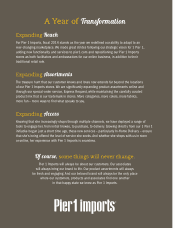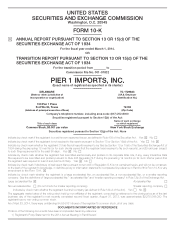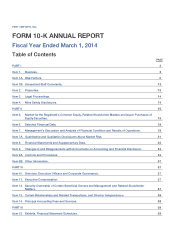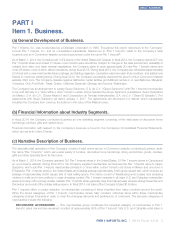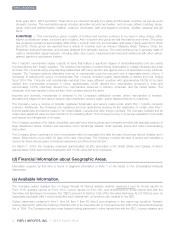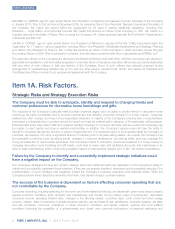Pier 1 2014 Annual Report Download - page 11
Download and view the complete annual report
Please find page 11 of the 2014 Pier 1 annual report below. You can navigate through the pages in the report by either clicking on the pages listed below, or by using the keyword search tool below to find specific information within the annual report.
ITEM 1A. RISK FACTORS.
security. Unfavorable changes in factors affecting discretionary spending could reduce demand for the Company’s products and
therefore lower sales and negatively impact the business and its financial results.
The Company outsources certain business processes to third-party vendors and has
certain business relationships that subject the Company to risks, including disruptions in
business and increased costs.
The Company outsources numerous business processes to third parties including gift card tracking and authorization, credit card
authorization and processing, store scheduling and time and attendance, store maintenance services, maintenance and support of
the Company’s website and e-Commerce platform, certain marketing services, insurance claims processing, customs filings and
reporting, domestic and ocean freight including certain processing functions, shipment and delivery of customer orders including in-
home delivery, certain merchandise compliance functions including testing, certain payroll processing and various tax filings, record
keeping for certain employment benefits including retirement plans and the stock purchase plan, and third party vendor auditing. In
addition, the Company also has business relationships with third parties to provide essential services such as the extension of credit to
its customers and maintenance of the Pier 1 rewards credit card program. The Company makes a diligent effort to ensure that all
providers of these services are observing proper internal control practices, such as redundant processing facilities; however, there are
no guarantees that failures will not occur. Failure of third parties to provide adequate services or the Company’s inability to arrange for
alternative providers on favorable terms in a timely manner could have a negative effect on the Company’s financial results.
An overall decline in the health of the United States economy and its impact on consumer
confidence and spending could negatively impact the Company’s financial results.
The recessions experienced by the United States in various years adversely affected the discretionary spending, savings and
investments of United States consumers. The resulting deterioration in consumer confidence and spending during those
recessionary periods resulted in consumers sacrificing purchases of discretionary items, including the Company’s merchandise,
which negatively impacted the Company’s financial results during those years. Such recessions could occur again and could
have a significant impact on the Company’s financial results.
Failure to control merchandise returns could negatively impact the business and financial
results.
The Company has established a provision for estimated merchandise returns based upon historical experience and other known
factors. If actual returns are greater than those projected by management, additional reductions of revenue could be recorded in
the future. Also, to the extent that returned merchandise is damaged, the Company may not receive full retail value from the
resale of the returned merchandise. Introductions of new merchandise, changes in merchandise mix, associate selling behavior,
merchandise quality issues, changes to the Company’s return policy, e-Commerce return behavior, changes in consumer
confidence, new delivery channels/methods or other competitive and general economic conditions may cause actual returns to
exceed the provision for estimated merchandise returns. An increase in merchandise returns that exceeds the Company’s
current provisions could negatively impact the business and financial results.
A disruption in the operation of the domestic portion of the Company’s supply chain,
including the e-Commerce website, could impact its ability to deliver merchandise to its
stores and customers, which could impact its sales and results of operations.
The Company maintains regional distribution centers in Maryland, Ohio, Texas, California, Georgia and Washington. At these
distribution centers, merchandise is received, allocated, and shipped to the Company’s stores, customers and e-Commerce
orders are fulfilled. Major catastrophic events such as natural disasters, fire or flooding, malfunction or disruption of the
information systems, a disruption in communication services or power outages, or shipping interruptions could delay distribution
of merchandise to the Company’s stores and customers. Such disruptions could have a negative impact on the Company’s
sales and results of operations.
Factors that may or may not be controllable by the Company may negatively affect the
Company’s financial results.
Increases in the Company’s costs that are beyond the Company’s control, including items such as increases in fuel and
transportation costs, higher interest rates, increases in losses from damaged merchandise, inflation, litigation, fluctuations in
foreign currency rates, higher costs of labor, labor disputes around the world, increases in the costs of insurance and healthcare,
increases in postage and media costs, higher tax rates and complying with changes in laws and regulations, including
accounting standards, may negatively impact the Company’s financial results.
PIER 1 IMPORTS, INC. 2014 Form 10-K 7


